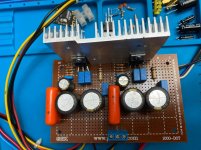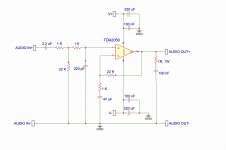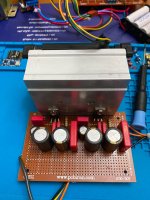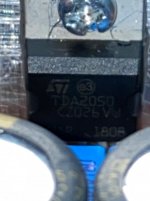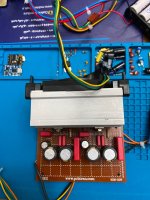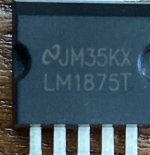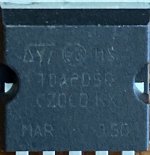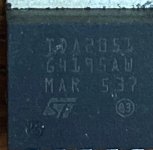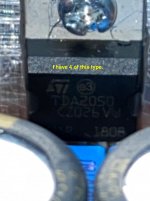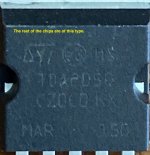Hi everybody,
This is my first post. Please consider me as an amateur with very basic knowledge about electronics and circuits.
After searching/reading this amazing forum for some time, I decided to start with TDA2050! And I built an stereo chip amp with two TDA2050. This is my first project.
I know that my chips are not authentic for sure (I used what was available). My caps do not seem to be authentic too. But anyway, I used what was available.
The power amp works just fine. No clipping, no distortion at all (dual 12V). The sound is good and powerful enough with my bookshelf Denon 6-Ohm speakers. The only point is that the sound is not as crystal clear as one expects!! The bass is fine but the high frequencies are missing.
I would be very thankful if you guys could help me improve the sound quality of my first project.
I have added both the schematic and a photo of the board. I should admit that the schematic is not mine, I just found it on the net and changed it a bit (decoupling caps).
Regards
This is my first post. Please consider me as an amateur with very basic knowledge about electronics and circuits.
After searching/reading this amazing forum for some time, I decided to start with TDA2050! And I built an stereo chip amp with two TDA2050. This is my first project.
I know that my chips are not authentic for sure (I used what was available). My caps do not seem to be authentic too. But anyway, I used what was available.
The power amp works just fine. No clipping, no distortion at all (dual 12V). The sound is good and powerful enough with my bookshelf Denon 6-Ohm speakers. The only point is that the sound is not as crystal clear as one expects!! The bass is fine but the high frequencies are missing.
I would be very thankful if you guys could help me improve the sound quality of my first project.
I have added both the schematic and a photo of the board. I should admit that the schematic is not mine, I just found it on the net and changed it a bit (decoupling caps).
Regards
Attachments
Hi everybody,
This is my first post. Please consider me as an amateur with very basic knowledge about electronics and circuits.
After searching/reading this amazing forum for some time, I decided to start with TDA2050! And I built an stereo chip amp with two TDA2050. This is my first project.
I know that my chips are not authentic for sure (I used what was available). My caps do not seem to be authentic too. But anyway, I used what was available.
The power amp works just fine. No clipping, no distortion at all (dual 12V). The sound is good and powerful enough with my bookshelf Denon 6-Ohm speakers. The only point is that the sound is not as crystal clear as one expects!! The bass is fine but the high frequencies are missing.
I would be very thankful if you guys could help me improve the sound quality of my first project.
I have added both the schematic and a photo of the board. I should admit that the schematic is not mine, I just found it on the net and changed it a bit (decoupling caps).
Regards
Looking at the schematic, I see no obvious mistakes. It looks quite usual.
Personal perceptions of lacking treble is difficult to comment on.
If you do not have access to an oscilloscope and a variable sine-wave generator, you can use a PC-soundcard and download free software from the Internet that allows you to use the PC-soundcard as a sine-wave generator and oscilloscope simultaneously. The idea is that you put the sine-wave signal at the amplifier input and the oscilloscope (PC-card input) at the amplifier output, perform a frequency scan from 200Hz to 20KHz (with constant amplitude at the input). The amplitude at the output should then also remain substantially constant in that frequency range.
It seems that you made a good job with your build-up on the Veroboard. It looks tidy.
Looking at the schematic, I see no obvious mistakes. It looks quite usual.
Personal perceptions of lacking treble is difficult to comment on.
If you do not have access to an oscilloscope and a variable sine-wave generator, you can use a PC-soundcard and download free software from the Internet that allows you to use the PC-soundcard as a sine-wave generator and oscilloscope simultaneously. The idea is that you put the sine-wave signal at the amplifier input and the oscilloscope (PC-card input) at the amplifier output, perform a frequency scan from 200Hz to 20KHz (with constant amplitude at the input). The amplitude at the output should then also remain substantially constant in that frequency range.
It seems that you made a good job with your build-up on the Veroboard. It looks tidy.
Thank you so much for your suggestion and clear explanation. Unfortunately I do not have neither an oscilloscope nor a PC-soundcard (I have an iMac). I will look for an oscilloscope to check what you have suggested.
Thanks a lot "nigelwright7557", I double checked everything. Everything is OK. The point is that, as I said, the bass is deep and powerful (SC-N9 speaker system) but the treble is diminished somehow!!!! I call it lack of details. I am not expert so this is my own interpretation.The only thing that might kill highs is the 220pf if its the wrong value.
I would double check that or remove one leg just to try it.
Hi farhad
As other wrote...its not easy to give you an idea without listening or oscilloscope to look at your "not expected" highs. what i mean is that sometime is that the powerful bass is too much that you are "fascinated" but this could be a lack of your missing the highs. Equalizer all to zero? What is your source?
your pcb looks well made and the components look ok from the pic.
without an other amp or other speakers it will not be easy to verify the sound "character" of the amp.
chris
As other wrote...its not easy to give you an idea without listening or oscilloscope to look at your "not expected" highs. what i mean is that sometime is that the powerful bass is too much that you are "fascinated" but this could be a lack of your missing the highs. Equalizer all to zero? What is your source?
your pcb looks well made and the components look ok from the pic.
without an other amp or other speakers it will not be easy to verify the sound "character" of the amp.
chris
Farhad,
Since several months i am enjoying the overall excellent sound of my DIY UTC-TDA2050 stereo amp. I really have no idea why your amp apparently is somehow failing in the "high frequencies".
Your schematic diagram and board look well done!
As Fauxfrench is suggesting try to perform some basic measurements if you can find access to the required measuring devices. (eg a frequency generator and an ac voltmeter or better an oscilloscope)
In stead of a frequency generator you may also consider to download clean Audicity tone wav files (including a 20-20k sweep.wav) from Johnaudiotech.
For sure you can play the wav files on your iMac
Look here>: Audio test files .
(For the Google drive download link look under "show more")
Finally, you are using fake "TDA2050's". I advise you to read the interesting posts of a.o Fauxfrench in the other LM1875 thread. Also JohnAudioTech has an interesting YouTube video on this subject. Some (fake) LM1875 or TDA2050's are quite ok, but some can really not be advised. See the thread.
Can you pse post a detailed photo or description of the actual chip you are using?
Since several months i am enjoying the overall excellent sound of my DIY UTC-TDA2050 stereo amp. I really have no idea why your amp apparently is somehow failing in the "high frequencies".
Your schematic diagram and board look well done!
As Fauxfrench is suggesting try to perform some basic measurements if you can find access to the required measuring devices. (eg a frequency generator and an ac voltmeter or better an oscilloscope)
In stead of a frequency generator you may also consider to download clean Audicity tone wav files (including a 20-20k sweep.wav) from Johnaudiotech.
For sure you can play the wav files on your iMac
Look here>: Audio test files .
(For the Google drive download link look under "show more")
Finally, you are using fake "TDA2050's". I advise you to read the interesting posts of a.o Fauxfrench in the other LM1875 thread. Also JohnAudioTech has an interesting YouTube video on this subject. Some (fake) LM1875 or TDA2050's are quite ok, but some can really not be advised. See the thread.
Can you pse post a detailed photo or description of the actual chip you are using?
Last edited:
This might also be of interest: a perceptual sweep file, so you could have a quick check whether this confirms your findings of the high frequency shortcomings.
Link>: Perceptual Sweep (20 Hz - 20 kHz)
Fred
Link>: Perceptual Sweep (20 Hz - 20 kHz)
Fred
Last edited:
Hi farhad
As other wrote...its not easy to give you an idea without listening or oscilloscope to look at your "not expected" highs. what i mean is that sometime is that the powerful bass is too much that you are "fascinated" but this could be a lack of your missing the highs. Equalizer all to zero? What is your source?
your pcb looks well made and the components look ok from the pic.
without an other amp or other speakers it will not be easy to verify the sound "character" of the amp.
chris
Dear chermann
Thanks for your reply. As a matter of fact I am using a Chinese MP3 player module. I also use its builtin Bluetooth. I do not dare connecting it to my iMac. I have no other speakers at hand. I will check as soon as I can get one and then report. As others have suggested, I need to check using an oscilloscope or something.
Dear fdenys, Thank you for your reply, I will follow your suggestion. In the meantime, I made another copy of the same amp according to the tda2050 datasheet without any changes (nothing at all). This one sounds much better. The caps are supposed to be authentic WIMA and Silmic Elna (but I cannot confirm that they are really authentic ones). I used a pair of the same tda2050 chips. So, do you think that the components might be a problem or the extra filter with 220PF cap? I am confused. I will post a pic of the chip.Farhad,
Since several months i am enjoying the overall excellent sound of my DIY UTC-TDA2050 stereo amp. I really have no idea why your amp apparently is somehow failing in the "high frequencies".
Your schematic diagram and board look well done!
As Fauxfrench is suggesting try to perform some basic measurements if you can find access to the required measuring devices. (eg a frequency generator and an ac voltmeter or better an oscilloscope)
In stead of a frequency generator you may also consider to download clean Audicity tone wav files (including a 20-20k sweep.wav) from Johnaudiotech.
For sure you can play the wav files on your iMac
Look here>: Audio test files .
(For the Google drive download link look under "show more")
Finally, you are using fake "TDA2050's". I advise you to read the interesting posts of a.o Fauxfrench in the other LM1875 thread. Also JohnAudioTech has an interesting YouTube video on this subject. Some (fake) LM1875 or TDA2050's are quite ok, but some can really not be advised. See the thread.
Can you pse post a detailed photo or description of the actual chip you are using?
Attachments
Dear FauxFrenchm, As I mentioned in previous post, I made another copy of the amp but this time I followed the datasheet with absolutely no changes. It sounds much better from high frequencies point of view. The sound is very load with no distortion. I have no idea why the first circuit is bass oriented and this one is kinda neutral and to my ears it has both high and low frequencies. I will follow your suggestions with an oscilloscope to undrestand the logic behind it.Looking at the schematic, I see no obvious mistakes. It looks quite usual.
Personal perceptions of lacking treble is difficult to comment on.
If you do not have access to an oscilloscope and a variable sine-wave generator, you can use a PC-soundcard and download free software from the Internet that allows you to use the PC-soundcard as a sine-wave generator and oscilloscope simultaneously. The idea is that you put the sine-wave signal at the amplifier input and the oscilloscope (PC-card input) at the amplifier output, perform a frequency scan from 200Hz to 20KHz (with constant amplitude at the input). The amplitude at the output should then also remain substantially constant in that frequency range.
It seems that you made a good job with your build-up on the Veroboard. It looks tidy.
Attachments
Farhad,
Thanks for posting a photo of the "fake" tda2050.
I believe this chip might be the problem.
Please read post #344 (and related follow up posts) of a.o. FauxFrench in the thread:
"LM1875 in parallel configuration and used in a composite amplifier".
In this interesting test he is comparing 6 pcs of LM1875/TDA2050 "fake" chips.
Believe your TDA2050 might be the one of his attached second picture (chip at the right).
Unfortunately this chip can not be recommended. I also had acquired a number of this particular chip, and can fully support FF findings.
My advise: preferably use a UTC-TDA2050 or genuine LM1875t.
Alternatively one of the "fake" LM1875's of the "well performing" specimens reported by FF in post #344
Thanks for posting a photo of the "fake" tda2050.
I believe this chip might be the problem.
Please read post #344 (and related follow up posts) of a.o. FauxFrench in the thread:
"LM1875 in parallel configuration and used in a composite amplifier".
In this interesting test he is comparing 6 pcs of LM1875/TDA2050 "fake" chips.
Believe your TDA2050 might be the one of his attached second picture (chip at the right).
Unfortunately this chip can not be recommended. I also had acquired a number of this particular chip, and can fully support FF findings.
My advise: preferably use a UTC-TDA2050 or genuine LM1875t.
Alternatively one of the "fake" LM1875's of the "well performing" specimens reported by FF in post #344
Last edited:
Hi farhad
to be sure which chips are "sounding" you might change the chips from board 1 to board 2 and other way round.
chris
Thank you so much for your advice. I will exchange the chips to see what happens.
Farhad,
Thanks for posting a photo of the "fake" tda2050.
I believe this chip might be the problem.
Please read post #344 (and related follow up posts) of a.o. FauxFrench in the thread:
"LM1875 in parallel configuration and used in a composite amplifier".
In this interesting test he is comparing 6 pcs of LM1875/TDA2050 "fake" chips.
Believe your TDA2050 might be the one of his attached second picture (chip at the right).
Unfortunately this chip can not be recommended. I also had acquired a number of this particular chip, and can fully support FF findings.
My advise: preferably use a UTC-TDA2050 or genuine LM1875t.
Alternatively one of the "fake" LM1875's of the "well performing" specimens reported by FF in post #344
Thank you so much for showing me the post by FauxFrench. very interesting. Unfortunately I do not have oscilloscope as I have already mentioned. Here I add photos of the chips that I have. I guess only my 2051 chips are fine. Is that correct?
Attachments
I forgot to say that I have 4 tda2050 chips which I am using right now on my boards (I sent a photo in previous posts). The rest of my tda2050 chips are of the type in the above post. Here I post a photo of my 4 chips that are already on my boards.
Attachments
Farhad,
In the meantime i found the 10pcs of fake TDA2050's in my possession.
At the time i tested and measured also these chips and rejected them, because they were far from the TDA2050 datasheet specs (for instance the measured output power).
Of course i compared my copy with your photo, and there is no doubt: they are identical.
I am also pretty sure we are talking about the same copy FauxFrench was referring to. These particular chips are no good.
On the other hand i believe your LM1875T might be ok, at least they look like a copy i also tested and found ok.
However remember that non of these chips have a (working) protection against short circuit of the output.
Contrary to the UTC-TDA2050 and genuine LM1875t which are both excellent chips.
I tried to find and purchase genuine LM1875's in local shops and gave up, they were all chinese fakes.
Finally i bought the UTC-TDA2050 which is a good quality chip and can be fully recommended. It is only about 1 Euro in Europe, so as a bonus it is very affordable too.
I would say first try the LM1875's in your possession, they might deliver good quality sound. The (missing) output protection, well i'am sure you can live with that..
Fred
In the meantime i found the 10pcs of fake TDA2050's in my possession.
At the time i tested and measured also these chips and rejected them, because they were far from the TDA2050 datasheet specs (for instance the measured output power).
Of course i compared my copy with your photo, and there is no doubt: they are identical.
I am also pretty sure we are talking about the same copy FauxFrench was referring to. These particular chips are no good.
On the other hand i believe your LM1875T might be ok, at least they look like a copy i also tested and found ok.
However remember that non of these chips have a (working) protection against short circuit of the output.
Contrary to the UTC-TDA2050 and genuine LM1875t which are both excellent chips.
I tried to find and purchase genuine LM1875's in local shops and gave up, they were all chinese fakes.
Finally i bought the UTC-TDA2050 which is a good quality chip and can be fully recommended. It is only about 1 Euro in Europe, so as a bonus it is very affordable too.
I would say first try the LM1875's in your possession, they might deliver good quality sound. The (missing) output protection, well i'am sure you can live with that..
Fred
Farhad,
In the meantime i found the 10pcs of fake TDA2050's in my possession.
At the time i tested and measured also these chips and rejected them, because they were far from the TDA2050 datasheet specs (for instance the measured output power).
Of course i compared my copy with your photo, and there is no doubt: they are identical.
I am also pretty sure we are talking about the same copy FauxFrench was referring to. These particular chips are no good.
On the other hand i believe your LM1875T might be ok, at least they look like a copy i also tested and found ok.
However remember that non of these chips have a (working) protection against short circuit of the output.
Contrary to the UTC-TDA2050 and genuine LM1875t which are both excellent chips.
I tried to find and purchase genuine LM1875's in local shops and gave up, they were all chinese fakes.
Finally i bought the UTC-TDA2050 which is a good quality chip and can be fully recommended. It is only about 1 Euro in Europe, so as a bonus it is very affordable too.
I would say first try the LM1875's in your possession, they might deliver good quality sound. The (missing) output protection, well i'am sure you can live with that..
Fred
fdenys, thank you so much for the info. At least I know where to start from now. I will give my LM1875 a try. At the same time I will check if I can have access to UTC-TDA2050. I doubt it.
- Status
- This old topic is closed. If you want to reopen this topic, contact a moderator using the "Report Post" button.
- Home
- Amplifiers
- Chip Amps
- TDA2050-Loss of details
